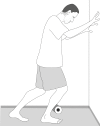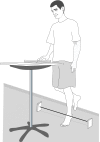Obesity and pronated foot type may increase the risk of chronic plantar heel pain: a matched case-control study
- PMID: 17506905
- PMCID: PMC1884155
- DOI: 10.1186/1471-2474-8-41
Obesity and pronated foot type may increase the risk of chronic plantar heel pain: a matched case-control study
Abstract
Background: Chronic plantar heel pain (CPHP) is one of the most common musculoskeletal disorders of the foot, yet its aetiology is poorly understood. The purpose of this study was to examine the association between CPHP and a number of commonly hypothesised causative factors.
Methods: Eighty participants with CPHP (33 males, 47 females, mean age 52.3 years, S.D. 11.7) were matched by age (+/- 2 years) and sex to 80 control participants (33 males, 47 females, mean age 51.9 years, S.D. 11.8). The two groups were then compared on body mass index (BMI), foot posture as measured by the Foot Posture Index (FPI), ankle dorsiflexion range of motion (ROM) as measured by the Dorsiflexion Lunge Test, occupational lower limb stress using the Occupational Rating Scale and calf endurance using the Standing Heel Rise Test.
Results: Univariate analysis demonstrated that the CPHP group had significantly greater BMI (29.8 +/- 5.4 kg/m2 vs. 27.5 +/- 4.9 kg/m2; P < 0.01), a more pronated foot posture (FPI score 2.4 +/- 3.3 vs. 1.1 +/- 2.3; P < 0.01) and greater ankle dorsiflexion ROM (45.1 +/- 7.1 degrees vs. 40.5 +/- 6.6 degrees; P < 0.01) than the control group. No difference was identified between the groups for calf endurance or time spent sitting, standing, walking on uneven ground, squatting, climbing or lifting. Multivariate logistic regression revealed that those with CPHP were more likely to be obese (BMI > or = 30 kg/m2) (OR 2.9, 95% CI 1.4 - 6.1, P < 0.01) and to have a pronated foot posture (FPI > or = 4) (OR 3.7, 95% CI 1.6 - 8.7, P < 0.01).
Conclusion: Obesity and pronated foot posture are associated with CPHP and may be risk factors for the development of the condition. Decreased ankle dorsiflexion, calf endurance and occupational lower limb stress may not play a role in CPHP.
Figures


References
-
- Rome K. Heel pain: diagnosis and management. Podiatry Now. 2005;8:S1–S8.
-
- Hunt GC, Sneed T, Hamann H, Chisam S. Biomechanical and histiological considerations for development of plantar fasciitis and evaluation of arch taping as a treatment option to control associated plantar heel pain: A single-subject design. The Foot. 2004;14:147–153. doi: 10.1016/j.foot.2004.03.007. - DOI
-
- Narvaez JA, Narvaez J, Ortega R, Aguilera C, Sanchez A, Andia E. Painful heel: MR imaging findings. Radiographics. 2000;20:333–352. - PubMed
-
- Rome K. Anthropometric and biomechanical risk factors in the development of plantar heel pain – a review of the literature. Physical Therapy Reviews. 1997;2:123–134.
Publication types
MeSH terms
LinkOut - more resources
Full Text Sources
Other Literature Sources
Medical

